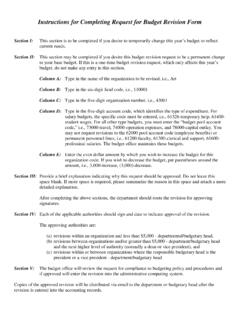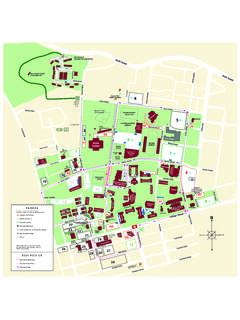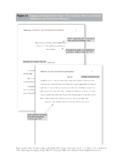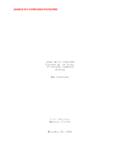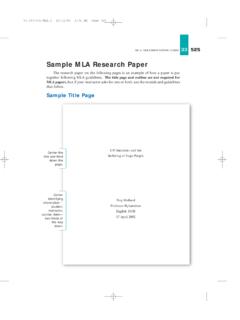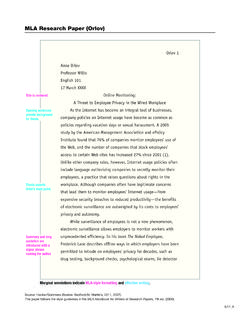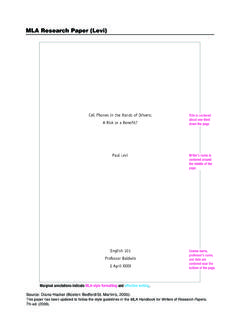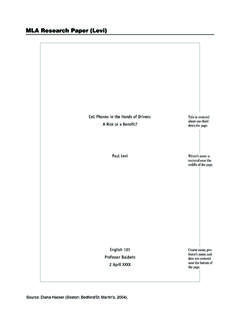Transcription of SAMPLE CHICAGO STYLE PAPER - Austin Peay State University
1 SAMPLE CHICAGO STYLE PAPER John Doe History 2010 Dr. Johnson July 11, 2013 Doe 1 The CHICAGO STYLE of writing is used for academic writing in the field of Humanities, especially history. Specific guidelines for formatting a PAPER in CHICAGO STYLE are outlined in manuals such as the 16th edition of the CHICAGO Manual of STYLE , which was issued in September 2010, and the 7th edition of A Pocket Guide to Writing in History by Mary Lynn Rampolla, which was issued in 2012. Papers that are written in CHICAGO STYLE should have a title page that presents the student s information. Included on this title page should be the title of the PAPER , the student s name, and the course information about the PAPER s class. The example title page of this example essay was modeled from Rampolla s pocket guide from page 146.
2 The margins should be one inch all the way around the page. The student s last name and page number should appear in the top right corner of each page (excluding the title page). Typically, a CHICAGO STYLE PAPER is written in Times New Roman, twelve-point font. Two basic documentation methods are used in a CHICAGO - STYLE PAPER . The first of these methods is the notes and bibliography method. This is the most common method and is the one history professors will most undoubtedly use. The second of these methods is the author-date method, which is far less common. This STYLE is used in a manner that is similar to MLA wherein a citation is given by using the author s last name and date of publication within a set of parenthesis after a For the purpose of this PAPER , though, the traditional notes and bibliography citation method will be discussed since it is the most widely used form of citation.
3 Please note that the colored highlighted sections of this PAPER should not be highlighted in a student s PAPER . These highlights are used to illustrate the connections between the number at the end of the quote and the corresponding endnote. Notes are to be used when the writer is referencing any ideas or text that did not come from his or her own mind. There are two types of notes that can be used in a CHICAGO STYLE Doe 2 PAPER : footnotes or endnotes. Footnotes are notes that are cited at the bottom footer part of the page. On the other hand, endnotes are notes that are collectively listed on a separate page at the end of the document before the Bibliography page. This example PAPER uses endnotes. When an endnote is needed, first, type the number 1 (or whichever number you need in consecutive order) after the period of the sentence with the quoted or paraphrased material.
4 Highlight the number and hit the exponent button in the toolbar (it looks like this: x2). Next, go to the end of your document to start the Notes page. Note the first line of the endnote, including the number, is indented while the next line is flush against the left margin. Each endnote should be single-spaced, but an extra line should be inserted between the last line of one endnote and the beginning of the next. The title of this page should say Notes, and the page should list the citations in the order they appear in your PAPER . For example, take a look at the citation in the second paragraph on the first page. There is a small number 1. Now, take a look at the Notes page on page 6. Do you see the corresponding 1 ? This is the first place where writers should put the bibliographic information for this source.
5 In this instance, it was information from the CHICAGO Manual of STYLE s website. Remember, though, this Notes page is not the bibliography. (The bibliography page is included at the end of the PAPER and lists the sources in alphabetical order according to author(s) last names. In addition, CHICAGO STYLE s bibliography page is very similar to APA STYLE s References page or MLA STYLE s Works Cited page). Footnotes can be added using Microsoft Word. First, open the References tab and click the button, Insert Footnote. This makes a small number appear to the right of the sentence that is in need of a reference. You will need to hit the exponent button (x2) to undo the superscript, and add a period followed by a space to start the citation; the way writers insert the bibliographic information for the footnote is exactly the same as it is for the endnote, the only difference being Doe 3 that the footnote s corresponding number appears at the bottom of the page rather than appearing on a separate page called Notes near the end of the PAPER .
6 What information should these notes contain? The answer to this question is, basically, the same information that goes in the bibliography. To illustrate, the following example is a quote that needs to be cited: regarding a revolt in England during the Wars of the Roses, the author notes, But the bloodshed and looting proved the rebels undoing. 2 Pay attention to the corresponding number 2 endnote. Notice, this source is a book written by one author. The author s name is presented as first name, then last; however, on the bibliography page, this source is cited as last name, first name. Take a look at the bibliography page to see the subtle differences. Here is another interesting fact about CHICAGO STYLE endnotes: the second time a writer uses the same source in succession, the abbreviation Ibid.
7 Can be used in the endnote to note it is from the same source. For example, Castor, the writer of the previous quote, claims, York s situation was now extremely perilous. 3 Note if the page number for this new citation is the same as for the previous citation, simply writing Ibid. (with no page number) will suffice. If the writer is using the same source a second time and it is not in succession, then a shortened form of the bibliographic information by simply putting the author s last name, a shortened form of the title, and the page number(s) of the citation is acceptable. To illustrate this procedure, here is a quotation from another source: The vast estates of the old feudal barons were broken up in to numerous independent manors. 4 Castor claims the Paston family sought to gain power by purchasing these Look at the endnote.
8 Notice the reference number 5 from Castor is shortened because the writer referred to this author s book somewhere prior to this in his or her PAPER ( , endnote 2). Doe 4 Next, a specific term or phrase can be cited rather than an entire line. Here is an example of a term found in an article from an online database that needs to be cited: The concept of mass Christianization of native peoples began with John Eliot in the 1600s when he established praying towns. 6 (This example mixes paraphrasing from the source with directly quoting a portion of it.) A citation is noted above the words praying towns. This reference contains the author s first then last name, the title of the article, the journal that the article is from, the volume number, the edition number, the year of publication, page numbers, and the URL for the online database.
9 The date of access is not needed because the year or publication is known. Note that, when writing for history, students should use scholarly articles that they can reference in their papers. Some reliable, scholarly online databases are Project Muse, JSTOR, and Academic One File. Books and articles are usually the main sources used in freshman level writing; however, upper division history writing may require a more detailed form of referencing. Sources from court documents to videos to congressional records require their own formats in which they must be cited. However, all citations will follow the same basic format as illustrated in this PAPER . The best way to find out how a source should be cited is to look it up in the CHICAGO Manual of STYLE , 16th edition, 7th edition of A Pocket Guide to Writing in History by Mary Lynn Rampolla, or online at the CHICAGO Manual of If a student simply googles some form of referencing that he or she is unsure about, only scholarly websites should be used.
10 Although CHICAGO STYLE is very different from both MLA and APA, it can be considered simple once a writer has adjusted to it. If writers run into difficulties with writing or citing, they can use all of the resources that are available such as the reliable CHICAGO STYLE manuals, the Writing Center, or the research Assistance Desk in the Woodward library on campus. Good luck Doe 5 with your writing! Doe 6 Notes 1. CHICAGO STYLE Citation Quick Guide, The CHICAGO Manual of STYLE , accessed April 23, 2013, 2. Helen Castor, Blood and Roses: One Family s Struggle and Triumph During the Tumultuous Wars of the Roses (New York: Harper Collins Publishers, 2006), 97. 3. Ibid., 148. 4. Vincent Redstone, Social Condition of England during the Wars of the Roses, Transactions of the Royal Historical Society 16 (1902): 159, /3678121.

